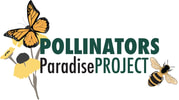A Plan for Hamilton
Hamilton needs a Pollinator Protection Plan! We've begun exploring what such a plan could look like. Such a plan includes working with residents, community partners, municipal staff and councillors to improve and protect pollinator habitat through municipal policy.
Actions we are currently working on/will be in the upcoming months towards this end include:
Many cities already have a Pollinator Protection Strategy. Toronto has one in the works. The draft strategy provides an overview of Toronto's bees and butterflies, a summary of the key guiding priorities that shape the strategy, and a series of proposed actions that will help us to protect and sustain healthy pollinator populations in Toronto.
The draft has identified six priorities for pollinator protection: 1. Creating and enhancing habitat, 2. Designing and connecting green spaces, 3. Partnering and building relationships, 4. Investing, incentivising and inspiring, 5. Educating and training, and 6. Celebrating and recognizing achievements.’
“A series of proposed actions include a review of the City’s mowing practices with a view to preserving pollinator habitat, and work with relevant City divisions and agencies to identify areas that could benefit from less frequent mowing, so more education and training for City staff and contractors, and doing targeted plantings,” says Annemarie Baynton, Senior Environmental Planner at the City of Toronto, the lead on the initiative and coordinator of the various divisions responsible for implementation elements of the strategy.
. For details on the priorities and proposed actions, visit the draft strategy here.
Now it's our turn to make Hamilton the best city to raise a pollinator by creating a strong pollinator protection plan to support resilient ecosystems that contribute to a rich urban biodiversity.
We need a Biodiversity Protection Strategy to protect not only pollinators, but all species. Check out our draft Biodiversity Protection Plan here. (SOON TO COME).
Actions we are currently working on/will be in the upcoming months towards this end include:
- Encouraging residents to ask their councilors for pollinator habitat protection in the urban Official Plan
- Creating a Pollinator Task Force composed of city staff (from planning, forestry, parks departments), conservation, and community groups to determine the best way to create and protect pollinator habitat across Hamilton.
- Researching the best methods to identify and map important pollinator habitat within Hamilton’s urban boundary.
Many cities already have a Pollinator Protection Strategy. Toronto has one in the works. The draft strategy provides an overview of Toronto's bees and butterflies, a summary of the key guiding priorities that shape the strategy, and a series of proposed actions that will help us to protect and sustain healthy pollinator populations in Toronto.
The draft has identified six priorities for pollinator protection: 1. Creating and enhancing habitat, 2. Designing and connecting green spaces, 3. Partnering and building relationships, 4. Investing, incentivising and inspiring, 5. Educating and training, and 6. Celebrating and recognizing achievements.’
“A series of proposed actions include a review of the City’s mowing practices with a view to preserving pollinator habitat, and work with relevant City divisions and agencies to identify areas that could benefit from less frequent mowing, so more education and training for City staff and contractors, and doing targeted plantings,” says Annemarie Baynton, Senior Environmental Planner at the City of Toronto, the lead on the initiative and coordinator of the various divisions responsible for implementation elements of the strategy.
. For details on the priorities and proposed actions, visit the draft strategy here.
Now it's our turn to make Hamilton the best city to raise a pollinator by creating a strong pollinator protection plan to support resilient ecosystems that contribute to a rich urban biodiversity.
We need a Biodiversity Protection Strategy to protect not only pollinators, but all species. Check out our draft Biodiversity Protection Plan here. (SOON TO COME).
